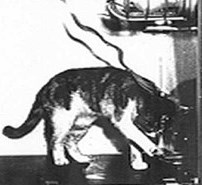Neurofeedback– The Cat’s Meow

“Ding!” a bell sounds in a dog kennel, almost instantly a hungry dog starts drooling, anticipating the food he knows is coming. This dog has been trained to associate the sound of a bell with the promise of a meal– a phenomenon known as classical conditioning. In the 1890s the psychologist Pavlov conducted groundbreaking research on how brains function and learn. Pavlov noticed that w
hen food was brought to hungry dogs they started drooling, as their salivary glands and stomach began producing digestive enzymes in anticipation of a meal. By associating food delivery with the sound of the bell, Pavlov was able to quickly train the hungry dogs and alter their natural physiological responses. Instead of salivation being stimulated by the smell of food, the trained dogs would being drooling at the sound of a bell.
Clearly the pizza man has done the same to me– the doorbell rings and I am drooling before I even smell my pizza– but that is besides the point.
Pavlov’s dog experiments were the basis for brain training. They have been altered and repeated time and time again and have been the foundation for much of today’s current beliefs on the psychology of learning. Whether we like it or not we are trained to associate certain stimulants with positive rewards or negative punishments. And, sometimes, like a doorbell and a meal, the stimulate and the reward or punishment are not even directly related. This serves as an indication that we can rewire our inborn physiological and psychological relationships through brain training.
Interestingly, Pavlov’s research was influential in early neurofeedback. When trying to expand upon Pavlov’s theories, one of the Nuerofeedback greats, Dr. Barry Sterman, discovered just how powerful brain training can be.
In 1963 Dr. Sterman was conducting Pavlov based experiments on cats. He would deny them food and then make them perform a task (pushing a lever) in order to be fed. However, unlike Pavlov, who’s measurable variable was salvation, Dr. Sterman had his kitty subjects hooked up to qEEGs. That’s right, as the cat’s worked to receive food Dr. Sterman measured their brain activity using the same technology we use to create brain maps. He quickly noticed that when the cats were in a state of great concentration, working out how to get food, their brain was functioning at frequencies from 13 to 15 Hz, the frequencies associated with concentration and focus. Dr. Sterman was interested in seeing if the felines could be trained to make their brain produce these frequencies. In later stages of the experiment, the only way for the cats to get food was for them to produce and then maintain the desired brain activity. Amazingly, Dr. Sterman’s cats, after only a few rounds of classical conditioning, were able to control their brain activity. With the promise of food that cats were able alter their brain waves to the desired 13 to 15 Hz on demand.
The true power of neurofeedback and brain training came years later with a fluke realization, when NASA recruited Dr. Sterman to conduct research on chemicals their astronauts would be exposed to. Dr. Sterman injected 50 cats with the agent– and within minutes saw the effects of the chemicals which caused many serious neurological side effects and even death. Amazingly, 10 of the cats seemed immune to the chemicals. What was different about those 10 lucky kitties? They had all been subjects in Sterman’s earlier experiments. It quickly became apparent that the brain training had made the cats immune to the devastating effects of the drugs. And, maybe more amazing, the effects had held for years.
This fluke discovery became the basis for brain training and neurofeedback. The research that was born from these discoveries and the discoveries of other influential scientists have been the framework for the neurofeedback protocols that are being run every day in our offices as we work to integrate neurofeedback with counseling in Bozeman and Belgrade. Thankfully, at the nCenter we are not depriving any cats of their dinner, but we are using the same general principle– attempting to retrain and even entrain brains to function at desired frequencies and improve the overall physical and mental health of our clients.
Blog by: Kat Afton
Photo: Courtesy of Neurofeedback Gold Coast, NASA 1967

